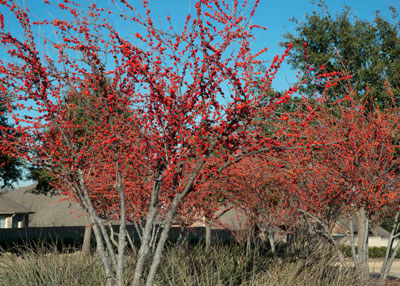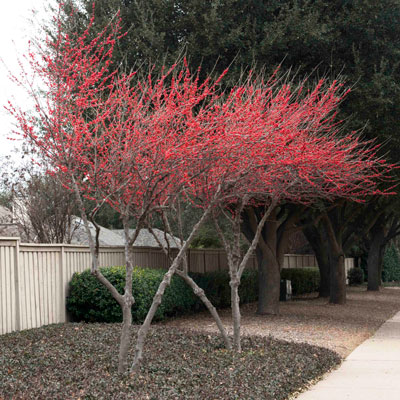Funny Name. Fabulous Plant.
I knew this plant from my childhood. There was a lovely specimen growing in a yard on North Avenue just a little bit west of Highway 6 (Texas Avenue) in Bryan. I admired it every winter.
Then I moved off to Ohio to finish my degrees at Ohio State. I came back to work in North Texas, and driving down Highway 121 between McKinney and Bonham, why there were hundreds of them growing in fields on both sides of the road.
That was about the time that my good friend the late Benny Simpson, one of Texas’ most beloved native plant experts, introduced me to an improved selection named Warren’s Red from the old Warren’s Nursery in Oklahoma City. Benny told me it had larger, redder berries and that it was less likely to send up root sprouts around the base of the mother plant. I soon saw that he was correct, and I’ve been in love with it ever since.

Photo: Warren’s Red possumhaw holly is eye-catching along Stonebridge Drive in McKinney in winter.
Basic facts about possumhaw hollies…
• Most hollies are evergreen. This plant is a rare member of the clan in that it’s deciduous. In fact, its scientific name is Ilex decidua.
• Its native range is from the eastern third of Texas north to eastern Kansas and east through southern Illinois to the Atlantic Ocean.
• Because it grows to 15 to 18 feet tall and 12 to 15 feet wide in multi-trunked clumps, many people refer to it as “deciduous yaupon.” The two plants do look very similar during the growing season. Possumhaw hollies are just a little more upright than yaupons. And bare of leaves all winter.
• In that latter respect, possumhaw hollies’ contribution to landscaping is a lot like that of crape myrtles. However, their colorful season runs November through February. That’s when the cedar waxwings move into town and make quick work of the berries.
• As with most hollies, possumhaw plants are either male or female. Only the female plants have the fabulous berries, which means that you really want to buy your plant during the winter, so you can see the proof of the fruit. Other than serving as pollen sources for all the lady possumhaws in town, male plants have little to offer in terms of landscaping value.

Photo: Warren’s Red possumhaw hollies highlight an otherwise drab wintertime landscape.
• Warren’s Red possumhaws are all grown from cuttings. They’re all female, berry-producing plants. Ask for them by name. Almost all independent retail garden centers either have them or can get them for you.
